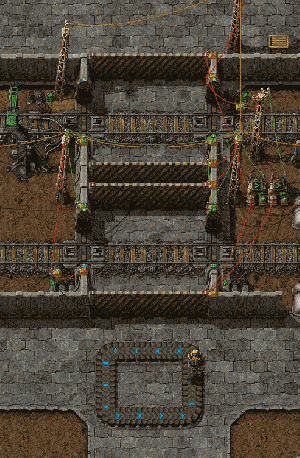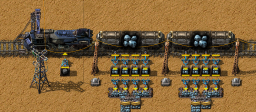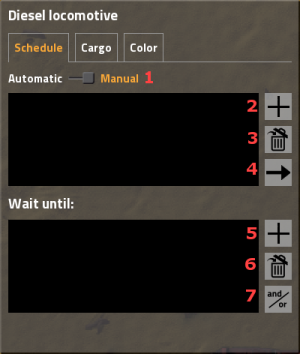User:Fried biter/workspace
作業場/workspace 日本語話者の方、マサカリ投げてくださると助かります
- テクノロジーに関しては鉄道技術(研究)をご覧ください。
鉄道(Railway)はFactorioにおける主要輸送手段の一種。導入は複雑になりえるし大量の資源と場所を食うが、特に長距離輸送に於いてはベルトやロボット物流より速くて効率的。
しかしながら、鉄道の建築は即座に理解できるようなものではない。自動輸送のような基本を学ぶのにもいくらかの時間がかかる。大規模な鉄道ネットワークを運営し維持してゆくことを学習するには時間と経験が必要となる。
インフラ
鉄道を建設するには、列車を乗せるための軌道(track。線路(rail)とも)を敷かねばならない。典型的にはレールプランナーで行われるが、手動でも可能。線路は2タイル単位で設置され、1タイルだけ動かすことは出来ないことに留意せよ。
最小限の手動運行鉄道
最小限の手動運行鉄道は以下から成る。
機関車のそばに立ってENTERを押下すれば乗り込んで手動運行できる。
分岐
- 分岐の作動状況に視覚的表現はないものの、レールは合流できる。レールプランナーを使えば、レールを既存レールに重ねて置くことで分岐を形成できる。分岐は路線上の枝分かれであり、列車に2方向の選択肢を与える。
- 列車は旋回角に制限があるため、2つの直線軌道が交差する点は分岐とはならない。信号ブロックを形成して衝突を防ぐことはできる。
- 並列軌道は相互に干渉しない。しかし、近すぎる場合には一方からもう一方への分岐が余計な資源を必要とする。軌道を一旦遠ざかる向きに伸ばし、そのあとで戻す必要がある。これは複雑な信号ネットワークの原因になるので、一般的には十分な間隔を開けずに並列軌道を敷くべきではない(ふつう軌道2本分の間隔で上手くいく)。

軌道の横断
軌道の横断には注意!列車はゲーム中で最も与ダメージが大きいものの一つであり、接触時にほとんどのプレイヤーを瞬殺する。
軌道を横断する際の適切な流儀チェックリスト。
- ズームアウトして列車が来るか見えるようにする。
- 左を見て、次に右を見る。
- 近傍の信号を確認。列車用信号が突然青から赤や黄色に変わったら、列車が来るので横断してはいけない。
- 完全には軌道上にいなくとも轢かれうるので、軌道付近を歩いてはいけない。
- 動いている列車に飛び乗ったり飛び降りたりもできるが、失敗の対価は命である。列車の側面もダメージ判定が有り、2台の列車の間で轢き潰されうる。
- 大量のシールドはダメージを軽減しうる。極端な場合には、体一つで列車を止めることすらできる。このためには瞬殺されないように相当なエネルギーシールドモジュールが必要で、スーツのエネルギーを大量に消費する。
- 体力を持つものなら列車に轢かれるとダメージを受けるので、自動車や戦車を軌道に放置しないように。この対象には敵勢力をも含むのだが。
- 駅から遠く離れた列車は(ほぼ)最高速で運行するので、横断の際はより警戒しズームアウトしておこう。駅や信号付近では止まるために減速しており、低速で運行する。設定が違っても早かったり遅かったりする。
図に示すような安全な路線横断が建設できる。これは接近中の列車がレールを予約したとき、軌道へのアクセスを制限する。プレイヤーがレール上に居る時は、回路ネットワークを介して信号は予約され、列車はプレイヤーが軌道を離れるまで停まって待たねばならない。プレイヤーが内部にいて軌道を横断しているとき、列車のゲートは閉じているので横断部以外の軌道にプレイヤーが踏み入ることは出来ない。これは完全に安全な横断を保証するので、サーバーでよく用いられる。
列車
列車は以下から成る。
| 機関車 | 貨物車両 | タンク貨車 | 曲射砲車両 |

- 列車は少なくとも1台の機関車を持つ。
- 列車は1台以上の機関車に加え、任意の数の貨車を持てる。
- 機関車は手動では前後に操縦できるが、一般には後ろ向きは遅い。左右キーは分岐で進行方向を変えるのに用いられる。
- 列車は自動操縦時には前にしか進めない。2台の機関車が逆向きに接続されていれば、自動化された列車も前にも後ろにも進める。
- 列車は運行に燃料が必要。燃料は列車が手動モード、または駅に停まっている場合にインサータで補充可能で、自動モードで信号前に停まっていたり運行中だったりする場合には補充不可能。
機関車のインベントリは燃料専用。貨物車両やタンク貨車にアイテムや流体を積み込むには、列車に接続されていなければならない。車両を接続するには、貨車にせよ機関車にせよ、既存列車に対し緑の接続予測が出るような近くの場所に設置するか、遠くで設置した場合にはプレイヤーが手動で接続(connect)キーを押すことで接続する。同様に切断(disconnect)キーで切断できる。貨物車両は手動、または最大12箇所の隣接するインサータ(片側6箇所)で、タンク貨車は最大3箇所のポンプで積み下ろしできる。ポンプは頂点にあるニップルと自動的に接続される。
列車駅

列車駅の構成要素
| 駅 | レール | インサータかポンプ |
列車駅(train station)は少なくとも1つの駅と、貨物車両やタンク貨車を積み下ろししたり機関車に燃料を積み込んだり曲射砲車両に弾薬を積み込んだり列車を修復したりするためのストレージや分配システムからなる。
列車駅(train stations)と駅(train stops)とを混同しないように。 列車駅は概念で、駅はアイテムである。
列車軌道に隣接してインサータを置くことで駅での積み下ろしができる。貨物車両や曲射砲車両にアイテムを自動で積み下ろしするにはインサータが唯一の手段である。タンク貨車の場合はポンプ。
Signals
The two types of signals in Factorio:
| Rail signal | Rail chain signal |
Understanding rail signals can be difficult. Several terms critical to understanding them are below:
- Rail segment
- A piece of track (one item).
- Segment
- A single path of continuous track without intersections or switches. This becomes important when signals are employed. The player may mouse over a segment to see its number. It's number is unique within the world, however does not start from 0 or 1.
- Block
- A set of segments defined by rail signals. By default every connected segment belongs to one block, no matter whether a train can drive on it or not, and even if it can be driven only in one direction (e.g. at a switch, both segments of the switch belong to the same block). The blocks are shown as colored lines on the rails when the player holds a rail or rail chain signal.
Rail signals are used to employ multiple trains automatically. Note that driving a train manually ignores most of the rules described here; other automatic trains will follow signaling indicted by the player's movement dynamically, however it will sometimes be not possible to avoid a collision for automatic trains if the player ignores red/yellow signals. Always beware automatic trains and give them the right of way.
See this forum post for a good explanation about blocks.
Basic Signaling Rules
- There can only be one train in a block at any time. A train spanning multiple blocks occupies them all.
- A red signal means that the following block is occupied by a train.
- A yellow signal means that a train is approaching and already has the approval to enter the following block.
- Rail signal/jas separate a new block and reflect its state: green - free, yellow - reserved, red - occupied
- Rail chain signal/jas separate a new block and reflect the state of the next Rail signal/ja(s): see above, blue - at least one of the paths is blocked, but not all
- A train can only pass a signal on the right of the track, or if there is a signal on both sides on the same rail segment. Of course, manual driving overrides this.
Deadlocks
A deadlock or gridlock can happen when every train is locked by another. In nearly every case two or more trains are standing so that every train blocks (by minimum) one other train.
Deadlock occurrence
Deadlocks occur when two or more trains are prevented from continuing through an intersection, due to an unsolvable signal conflict. There are a few different types of deadlocks:
- Temporary - These are caused by a temporary hiccup in a train's path, such as a loading train being in the way, or created by closing a signal with the circuit network/ja. These often resolve themselves.
- Semi-permanent - These are the result of a problem with pathing, often created by a fuel-less train or broken rail, and may require player interaction to resolve, or (in the case of broken rails) may be corrected automatically by construction robots.
- Permanent - This type is the worst, and cannot be resolved automatically, often requiring the player to manually drive several trains to get them out of the intersection. These often are caused by incorrect signal placement or unreachable stations.
It's important to remember that deadlocks can happen by chance, and by mistake of the player. Sometimes even perfectly signaled rails have issues. The rate of deadlocks is inversely proportional to the quality of signaling, however.
Factors that influence the deadlock chance
- Train length (shorter trains will have a lower chance with the same rail/signal layout, due to having less effect on the rails they're on.)
- Size of the blocks: More space for the blocks means lower chance of deadlock.
- Track layout: Some layouts have a higher chance of locking than others.
- Quantity of trains - More trains trying to use an intersection will result in higher chance of deadlock.
- The chance is also much higher if trains need to wait often in areas with rail-crossings.
Knowing the factors, how can deadlocks be reduced?
- Don't use 4-way junctions or roundabouts (circles) to create junctions.
- Use better 3-way junctions. See A Detailed Look at a Bidirectional Three-way Train Intersection
- Use roundabouts only for changing direction of train, and never for high traffic intersections.
- Build more tracks around junctions. Don't have one junction be the only way to reach a place, add redundancy. This keeps a small problem a small problem.
Automated transport

Trains set on "Automatic" choose their destination stop and route on departure, and after waiting at a chain signal for five seconds, and when their destination stop disables itself by circuit condition. They choose the shortest route using a path finding algorithm/ja| that will get them to an enabled train stop with the right name, taking penalties for any apparent-at-the-time delays into account. If no such train stop exists they will skip the stop and go on to the next.
This section covers items used to make trains automatically transport items between stations. The player should be familiar with creating a rail system.
First, the player has to setup a rail system with at least two train stops, which are placed in the right-hand side of the expected train arrival direction. By hovering over the train stop with the mouse you see the positions of the vehicles for better setting up the train station (including (un)loading machinery, refueling/repair installations).
When you set up the train schedule (see below) and fuel the train, you can start the train on it's schedule by switching from manual to automatic driving mode.
Train schedule
The player can set up a list of train stations in the upper window. The train will route to stops in the given order, if it's at the end it will continue with the first. Currently, it's not possible to make a one-time schedule. Stations can be added by clicking button 2 (see picture). A pop-up appears with a list of all stop names. If you select one, another pop-up appears for you to select a wait condition.
Wait conditions are used to tell the train when to leave the station. There are 7 types of wait conditions:
- Time passed
- Inventory full - All inventories of the train are full.
- Inventory empty - Same as above, but empty.
- Item count - The train (all cargoes summed) contains a specific amount of a certain item.
- Circuit condition - The train stop is connectable to the Circuit network/ja, so the signals can used for wait conditions.
- Inactivity - No items were added or removed for the specified amount of seconds.
- Fluid count - The train (all fluid wagons summed) contains a specific amount of a certain fluid.
Hereafter the word "term" is used to describe one type of wait condition, and the words "wait condition" are used to describe the whole set of terms (it turns a bit into maths).
If you add more than one term, you can change the connection of those using the logical operators AND and OR (button 7). An AND condition will result in true if all terms are true. An OR condition will return true if at least one of the terms is true.
When mixing AND and OR terms, the logic is grouped by the OR terms. When evaluating the wait condition, the first term is evaluated along with all AND terms immediately following up to but excluding the next occurring OR term. If they all evaluate true, the wait condition evaluates true. Otherwise, evaluation continues with that next occurring OR term and all AND terms immediately following it, up to the next OR term. This continues until either an OR group evaluates true and the wait condition is satisfied, or all terms have been checked.
Examples
Expand for examples
Wait until full, up to 30 seconds:
Full cargo inventory OR 30 seconds passed
Wait until cargo full, or circuit condition Oil > 3000:
Full cargo inventory OR Circuit condition - Oil > 3000
Wait until empty, and 30 seconds passed, and 5 seconds of inactivity:
Empty cargo inventory AND 30 seconds passed AND 5 seconds of inactivity
Wait until iron ore is low, or copper ore is low and at least 30 seconds passed:
Cargo: Iron ore < 500 AND 30 seconds passed OR Cargo: Copper ore < 500 AND 30 seconds passed
Factorio's wait condition logic is read as disjunctive normal form (DNF), and so this last example is processed as (note the parenthesis):
((Cargo: Iron ore < 500 AND 30 seconds passed) OR (Cargo: Copper ore < 500 AND 30 seconds passed))
Which is the same as this:
((Cargo: Iron ore < 500 OR Cargo: Copper ore < 500) AND 30 seconds passed)
Unfortunately, there is no way to write that shorter form in the current UI.
Troubleshooting
Below are some things to verify if a rail system or train is not working.
- Is the train fueled? Ensure that the locomotive has fuel/ja of some kind.
- Misplaced or non-functional switches? Ensure that the train can plan a path through the switches.
- Another train on the same segment/ja| or block/ja|? Make sure the path of the train is unobstructed.
- Train stops placed correctly? Make sure that the yellow arrows when hovering on the stop point towards the end or exit of the stop.
- Is the train allowed to enter signals from the right direction? Are the signals set correctly?
- If a track is supposed to be two-way, the rail signals should be opposite each other. You can verify they match up by hovering the cursor over one. For a matched pair, it will show the other.
No path
When trains cannot reach the target, a "no path" symbol pops up over the locomotive. Check:
- Can the train reach its current destination by only driving forward? Build turning slopes or place a locomotive at both ends of a train!
- Are the train stops standing in the right direction? Train stops must be on the right hand side of the track.
- If you use rail signals, check that the signals are all allowing traffic in the correct direction.
- Check for interruptions in the train tracks, drive to the station manually to check there are no rail parts missing. Especially near junctions these can be hard to spot if missing.
If you are still having problems, consider:
- Driving the train manually, and as you pass each switch, try switching to automatic. When it works, you will know the rough area of the problem.
A pictorial summary of typical problems.
Achievements

|
Trans-Factorio express Have a train plan a path 1,000 tiles or longer. |
Connection to OpenTTD
Factorio's railway system works basically exactly like the block signals in Open Traffic Tycoon Deluxe. Players who have ever played that game will find some elements of it in Factorio. If not, they can learn from the OpenTTD documentation.